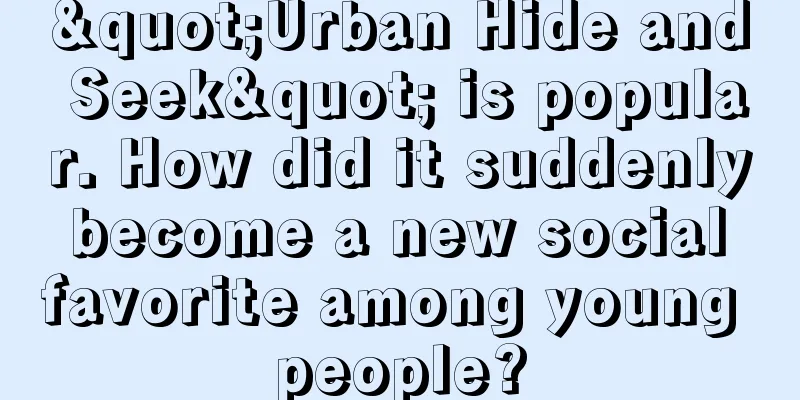"Urban Hide and Seek" is popular. How did it suddenly become a new social favorite among young people?

This generation of young people want "both". They are no longer willing to repeat the boring fitness routine like "ascetic monks", but at the same time they are eager to move to gain a healthy body. The "urban hide-and-seek" that has become popular in various cities recently is the latest "answer" from young people. With the support of technology, the relationships we build with others are no longer limited to "being together", but can be based on "knowing where others are". How will it affect our relationships with others? 1. Turn on the positioning and you will be transformed!Compared with the "hide and seek" we played when we were children, the biggest difference of "city hide and seek" is that it has the technical support of real-time shared positioning. The gameplay is very simple: 20-50 people form a team, divided into two roles: "cat" and "mouse", create a group on the map software and enable real-time geographic location sharing, and then you can start playing. Generally speaking, event organizers will charge a fee of 9.9-29.9 yuan, purchase insurance for participants, and provide glow sticks to distinguish the identities of "cats" and "mouse". When a "cat" catches a "mouse", the "mouse" will become a member of the "cat" and give its glow stick to the "cat". In the end, the cat that catches the most "mouse" is the "cat king", and the "mouse" that lives the longest is the "mouse king". Because it is combined with real-time positioning, the geographical scope of the game, although limited, will be much larger than traditional "cat and mouse" and can accommodate far more participants than before. In addition, the "new tradition" of changing avatars has been formed during the game's dissemination process - using the familiar Tom & Jerry as a unified "cat" and "mouse" avatar, making the activities more interesting when presented on the map. More importantly, when the avatar is changed and the positioning is turned on, the player enters another "identity" and finds a group of "allies". Whether you are a "cat" or a "mouse", running after positioning is turned on is no longer a boring exercise, but a battle of wits and courage that involves entering the role. During the process of playing, many "cats" and "mice" gathered together, found "common goals" with strangers they met for the first time nearby, and formed a natural connection. This also reminds me of another very classic location-based game "Ingress", which also allows a group of strangers to "come together". This game, which first began public testing in 2013 and was developed by Niantic Labs, the developer of Pokemon Go, had already been downloaded 20 million times worldwide in 2018. In this game, players can choose to become the "Enlightened" or the "Resistance". The main task is to use positioning to find "portals" around the world and gain control of the "portals" for their team. To some extent, this game is also a new variation of the traditional game "Capture the Flag" that combines positioning and AR technology. Compared with "City Hide and Seek", it is a longer-term game, but it also has the same "transformation" charm: This game has a "secret agent" feel. A data architect named RM Harman said that he lives in Silicon Valley and likes to ride his bicycle to recapture the portals around him. It's also a game that gives you a boost in exercise. At one point, Harman and his friends and partner hiked to a remote area near Yosemite National Park to restore some portals that had been taken over by an opponent. Once the positioning is opened, exercise becomes a "means" and adventure becomes the goal. Like "City Hide and Seek", Ingress provides an "excuse" for relatively shy players to get to know others. At one point, when the rebels gathered to retake the portal to a lighthouse in Brooklyn’s Prospect Park, Harman even flew from San Francisco to New York to join. In the information age, personal real-time location information is undoubtedly an important privacy data and should not be shared easily. At the same time, it has also become a key to social interaction. When we hand over this data, we also enter a new network of relationships, and often gain a new identity and alliance. It is a sign of "trust" and "openness" over a certain period of time. When the event ends or we close the game, the key will be taken back and the door will be closed again. However, when the door opened by this key is set to "always open", the boundary between people and the network becomes blurred. What impact will that have? How will it change the relationship between us and others? 2. Starting with Trust and Moving to Suspicion97 people! Hailey Todhunter had no idea that 97 people on her iPhone's Find My app would have permission to track her real-time phone location. No, her phone was not hacked by rogue software, nor did Find My have a security vulnerability. These people were the ones she had agreed to share her location with. This sounds unbelievable. However, for 23-year-old Todhunter and many Americans born after 1995, giving friends permission to view their location in real time is just like adding them on WeChat. Just as elementary school students now wear smart watches, Gen Z has been accustomed to being "tracked" by their parents using digital tools since childhood. The tracking here may be grades - many middle schools require teachers to upload every homework grade of students to the school system, and parents can check their children's grades at any time; It could also be "driving safety" - the family social network app Life360 provides a special "Drive Protect" feature that can track teenagers' driving speed, whether they use their mobile phones while driving, whether they suddenly accelerate, etc. Of course, there’s also location tracking — some parents continue to track their kids even after they go off to college. Therefore, geographical location has become not such a big deal in the eyes of some Gen Z. Every time Daniel, 26, talks about how good location sharing is, his parents blame him for disregarding privacy and security:
Sharing your real-time geographic location has become a kind of social currency - "I trust you". It is undeniable that location sharing does have many practical scenarios for young people to socialize: It can make appointments easier - when you hang out with friends, sharing your real-time location can reduce the hassle of back-and-forth communication, prevent your friends from saying "I'll be there in five minutes!", and even become an accurate short-distance navigation tool. Another way to "report safety" - when friends who go out together return home, they can check each other's location to see if they have arrived home. Instant Party Formation Guide - If you suddenly want to go out and play, turn on the location to see who is nearby. However, the flip side of convenience and intimacy is social anxiety and internal friction. In the past, you would hear on Monday that someone seemed to be going out on the weekend without inviting you, but now you can see which people are gathering together on the real-time location map on the weekend. One study found that 45% of adolescent girls surveyed believed that location sharing had a negative impact on them. If in the past you had to consider your personal image when posting things on social media, in the social age of shared geographic location, you have to think carefully about where you go next. Not to mention the inner pressure of feeling suspicious when you see your good friends getting together in real time and you are not invited, but not daring to raise questions openly. It becomes, “Well, they must have plans to go out, which means they have a group that doesn’t include me, so why am I not in it? Are they saying bad things about me in the group?” The symbol that originally symbolized "trust" has become the origin of "suspicion". Now, more organizations concerned with adolescent mental health are beginning to pay attention to this area, because "the excessive thinking generated is exactly the factor that affects mental health." As technology evolves, it becomes increasingly easy for us to get caught in the web. The Internet has brought us into a network that connects us to the world, mobile Internet has brought us into a network of "always online", and real-time location sharing has brought us into a social life that is almost completely transparent at all times. "Urban Hide and Seek" can also be regarded as a reminder that sometimes comfortable socializing and sharing should have boundaries and time limits. As technology becomes more and more convenient and seamless, sometimes we need to take the initiative to set boundaries and maintain our independence. Author: Fang Jiawen Source: WeChat public account "Ifanr (ID: ifanr)" |
<<: Douyin joins the e-commerce platform "Hourly Delivery", and instant delivery is open!
Recommend
What causes low Amazon product ratings? How to avoid them?
On the Amazon platform, there are many products wh...
How often does Amazon update its best sellers? Why does the organic ranking drop?
Merchants who open stores on Amazon will pay atten...
Another dark horse emerges in the comedy track, @小叮当的一家 becomes popular with sisters with different personalities
Nowadays, the comedy track is becoming more and mo...
How to get coupons on Amazon Global Shopping? How to use them?
When shopping on Amazon Global Shopping, you can s...
Guangzhou subway personal billboards become popular, and regional media returns to individuals and local life
Recently, the topic #Guangzhou Metro allows indivi...
How to double the sales of 200 million yuan
This article selects six problems that may be enco...
When is Amazon's Black Friday Cyber Monday? What can you do to prepare?
Amazon is a relatively well-developed cross-border...
Can a new Amazon store be linked to a store assistant? How to link to a store assistant?
I believe that those who do cross-border e-commerc...
You can’t make money by shooting Douyin videos because you are doing it wrong!
Everyone knows the monetization ability of Douyin ...
Brands are closing down one after another. Here are 11 suggestions for new consumption to find a way out.
Recently, we have heard news of brands going bankr...
How do tea, fresh produce, and traditional nourishing businesses with strong categories and weak brands make a fortune quietly in the live broadcast room?
As a traditional industry that is less affected by...
What should I do if Shopee is unable to ship the goods in time? What will happen if the goods are shipped overdue?
For e-commerce, product selection, title, detail p...
How do freelancers price themselves?
The income of freelancers is quite fluctuating, bu...
Becoming a rural internet celebrity
Rural themes are particularly popular during holid...
Short dramas are rushing towards brand customization. How many "Korean series" can they create?
After Hansu became popular in Jiang Shiqi's sh...









